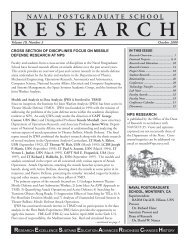Spectral Unmixing Applied to Desert Soils for the - Naval ...
Spectral Unmixing Applied to Desert Soils for the - Naval ...
Spectral Unmixing Applied to Desert Soils for the - Naval ...
Create successful ePaper yourself
Turn your PDF publications into a flip-book with our unique Google optimized e-Paper software.
2004), especially in cases where materials are spilled. Adding Nitrogen <strong>to</strong> soil has<br />
demonstrated a retarding effect on natural nitrogen fixation by soil organisms (Asner and<br />
Heidebrecht, 2002; Johns<strong>to</strong>n, 1997), however, studies on <strong>the</strong> relationship between<br />
nutrient availability and BSC abundance are limited (Bowker et al., 2005). The study by<br />
Bowker et al. (2005) had data supporting <strong>the</strong> correlation between BSC abundance and<br />
micronutrient availability. They found that in particular, Mn and Zn, had a strong<br />
relationship <strong>to</strong> <strong>the</strong> abundance of BSCs which could be useful in determining where soil<br />
crusts are located based on spectral signatures of soil composition. Overall, components<br />
of BSCs were positively correlated with nutrient availability. Because it is thought that<br />
BSCs are useful in moni<strong>to</strong>ring <strong>the</strong> condition of various rangelands and determining when<br />
res<strong>to</strong>ration ef<strong>for</strong>ts are successful, it makes sense that <strong>the</strong>y can also be useful as indica<strong>to</strong>rs<br />
of when ecosystems are becoming off balance, and if <strong>the</strong>re is an anthropogenic impact<br />
occurring in <strong>the</strong>ir region of growth causing <strong>the</strong> balance shift <strong>to</strong> occur (Haboudane et al.,<br />
2008; Webb et al., 2009).<br />
According <strong>to</strong> Evans et al. (1999) cryp<strong>to</strong>biotic crusts in arid environments are<br />
especially susceptible <strong>to</strong> degradation resulting from land use changes and o<strong>the</strong>r impacts<br />
from both anthropogenic and natural causes. Direct crustal damage is most often in <strong>the</strong><br />
<strong>for</strong>m of trampling because it breaks up sheaths and filaments which hold crustal soils<br />
<strong>to</strong>ge<strong>the</strong>r (Johns<strong>to</strong>n, 1997). If soil properties can be altered with even minimal<br />
impacts/disturbances (Prose, 1985), <strong>the</strong>n <strong>the</strong> loss of permeability <strong>to</strong> water, changes in<br />
nutrient availability, and structural breakdown-related stresses should also register on a<br />
spectral level (Smith et al., 2004; Weber et al., 2008). Studies have demonstrated that<br />
activities related <strong>to</strong> <strong>the</strong> military, overland recreational vehicles (ORVs) such as dirt<br />
bikes/all-terrain vehicles, hiking, biking, and lives<strong>to</strong>ck grazing place a heavy <strong>to</strong>ll on<br />
BSCs because of unsuccessful adaptations <strong>to</strong> compressional disturbances such as<br />
trampling (Johns<strong>to</strong>n, 1997). The organisms comprising <strong>the</strong> crust have a different range<br />
of sensitivities with <strong>the</strong> dominant species being partially affected/determined by<br />
microclimate. In particular an absorption feature related <strong>to</strong> chlorophyll A at 680 nm<br />
differentiates <strong>the</strong> BSCs from bare soil (O'Neill, 1994; Weber et al., 2008). Since this<br />
feature has shown responses <strong>to</strong> <strong>the</strong> addition of water in a study done by O’Neill (1994) it<br />
25
















